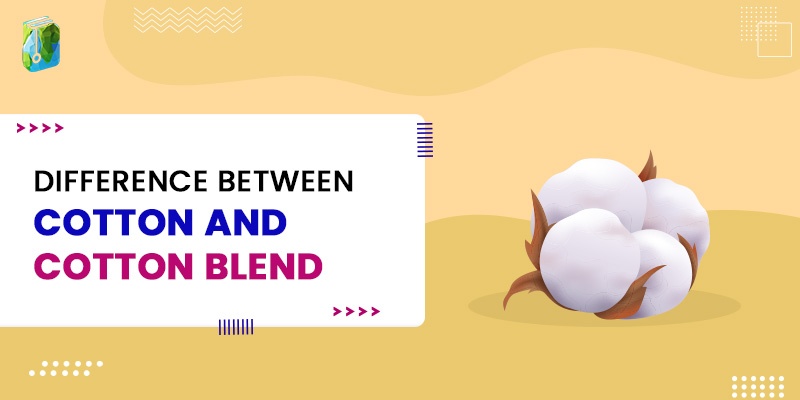Cotton and cotton blends (cotton mixed with other fibers) are used to make different clothes, such as shirts, dresses, t-shirts, and pants. Most people think that clothes made from cotton are better than clothes made from a cotton blend. The major difference between cotton and cotton blends is that cotton shrinks easily and requires high maintenance. On the other hand, cotton blends do not shrink and stay the same.
Difference Between Cotton and Cotton Blend
What is Cotton?
Cotton comes from the very soft, fluffy seeds of a cotton plant. This soft and fibrous substance is used to make thread and fabric.
As we all know, cotton is used in the textile and clothing industry. It produces various daily wear clothing like t-shirts, shirts, towels, underwear, robes, and pants. Since cotton is lightweight and soft, most people wear it in summer.
The only disadvantage is that if the cotton clothes are not maintained properly, they shrink over time. So, you need to take good care of them.
Did you know that cotton is also blended with other fabrics to benefit from both cotton and other materials?
Although cotton is pure and effective than cotton blends, most blended cotton fabrics are stronger and easier to maintain than the cotton fabric itself.
What Is Cotton Blend?
When blended with other fabrics such as rayon, linen, and polyester, cotton helps produce stronger and more attractive clothing. In blended cotton fabrics, the material consists of around 80% of cotton. This helps to give a very soft cotton comfort and texture.
When we blend cotton with linen, the cloth fabric is light, breathable, and shrinks easily. It is also very comfortable for the summer season. However, the cotton and linen blend is lighter and thinner than the pure cotton fabric.
On the other hand, synthetic fabrics (polyester and rayon) give your fabric an extra shine which is not seen in pure cotton fabrics..
One more advantage of blended cotton fabrics is that they are easy to maintain, stronger, and do not shrink easily.
Cotton Vs Cotton Blend: A Tabular Comparison
| Parameters | Cotton | Blended Cotton |
|---|---|---|
| Composition | 100% natural cotton fibres | Cotton blended with synthetic fibers like polyester, nylon, spandex |
| Breathability | Highly breathable, it allows airflow through the fabric | Retains some breathability but is reduced due to synthetic fiber content |
| Comfort | Exceptional comfort, especially in warm and humid climates | Relatively comfortable but can feel warmer due to reduced airflow |
| Moisture Wicking | Sweat is absorbed by the cotton fibers and wicked to the surface to evaporate. | Lower moisture absorption and wicking capacity compared to 100% cotton |
| Texture | Soft, smooth, or coarse texture, depending on the cotton type | Smooth texture, which may feel less natural next to skin |
| Thermal Properties | Good heat conduction to keep warm in winters and cool in summers | Improved insulation to retain body heat compared to 100% cotton |
| Opacity | Densely woven cotton can be thicker and prevent light from passing through | Blended fabric tends to be more translucent or sheer |
| Pilling Resistance | Loose cotton fibers may pill and ball up on the surface | More resistant to pilling and fuzzing |
| Wrinkle Resistance | Tends to wrinkle easily during wear and requires ironing | Resists wrinkling and retains shape well after washing |
| Durability | Withstands frequent use and washing without considerable wear | Relatively durable but may be prone to shrinkage over time |
| Colour Retention | Natural cotton fibers hold and reflect colors well after multiple washes | Colours may fade faster compared to natural cotton |
| Skin Allergies | Well-tolerated by most skin types with low irritation | Potential skin irritation in sensitive individuals due to synthetic fibers |
| Sustainability | Renewable and biodegradable material | Not fully biodegradable, microplastic pollution concern |
| Price | Typically, a more affordable option | Blended versions cost more due to advanced synthetic fibers |
Conclusion
The major difference between cotton and cotton blends is that cotton comes from a cotton plant’s soft, fluffy seeds. It is used mainly in the textile and clothing industry to produce t-shirts, shirts, towels, underwear, robes, pants, and more. On the other hand, cotton blend refers to mixing cotton with other fabrics like rayon, linen, and polyester. Cotton helps produce stronger and more attractive clothing. Here, we mentioned the difference between cotton and cotton blends.
People are also reading:

